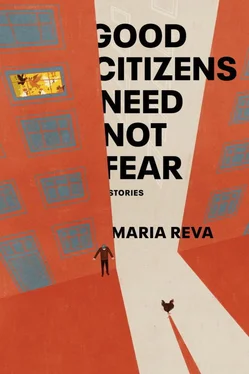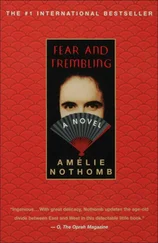—
After hearing about Zaya’s childhood, Almaza said: “What you need to do is harness all that authentic trauma into something great. A waste of trauma not to.” She suggested Zaya could invent a raw new dance style. Immortalize her woes in a brutal tile mural. She could write a memoir.
“Just look at that other orphan, the one all over the news,” Almaza reminded Zaya. The girl had grown up in an internat like Zaya’s, and couldn’t walk. Not that it stopped her from dreaming. She got herself adopted by a Finnish philanthropist, endured ten spinal surgeries, regained a bit of feeling in her right leg, and became a Paralympic gymnast. Inspired the whole country. She even posed for a beauty magazine, her long legs model thin.
—
Upon arrival at the internat, Zaya is disappointed to find the place intact. Even though she’d been absent for a short three years, she’d imagined coming upon a pile of bricks and plaster, impossible to reassemble. But the building stands; lush vines seal its cracks, cushion the iron fence. The vines shroud the mounds where the children were buried, and the unfilled pits, too—a relief, for Zaya. As a child, she had feared being mistaken for dead, waking up buried in one of these pits.
Now the grounds look charming, with the buttercups dotting the wild grass, the gates thrown open in welcome.
The clients—a venture capitalist, a socialite, a steel magnate, a lifestyle manager—are due to arrive the next morning. In preparation Zaya oils the gates’ locks, mops the floors, stocks the canteen with food, straightens the rows of beds in the nave of the monastery. Cold, dim, with spider egg sacs suspended in the stone moldings, the hall still possesses an underground quality.
Zaya tries to remember which bed was hers. To pass the time as a child she’d stand on her bed, use a sharp rock to scratch open the tight-lipped mouths of the men frescoed on the walls. But it appears that other children took up the practice after her time: now every mouth within reach is agape, as if the painted figures are shocked to find themselves, after so many centuries, in the same stultifying place.
Roaming the chambers and corridors, Zaya feels a sudden absence on her hip, as though something has been carved from her side. She recalls she used to carry the mummified saint, in a pillowcase propped on her hip, not because she wanted its companionship day and night—the creature smelled like a stale dishrag—but to keep the other children from stealing it, yanking its hair.
In the back of the building, Zaya discovers a small cell-like room with bare plaster walls and an adult-size bed, likely for a sanitarka. She rolls out a sleeping bag. The thin straw mattress, ripping at the seams, is just as hard as the ones on the children’s beds.
—
What about that other famous orphan, Almaza has reminded Zaya. When that girl’s orphanage ran out of money, the sanitarki chopped off the children’s braids and sold them to an Italian wig maker. Virgin hair, untouched by chemicals or curling irons. So what did this girl do when she got out? She started her own wig-making business, and partnered with a temple in India where the women cede their braids by choice, as an offering. Almaza herself owned one of these wigs back in Moscow. Finely woven, by three-strand bunches. It cost her fifteen thousand USD for one wig. Now the orphan drives a nice car, owns an apartment with French doors.
What does Zaya think of that? What’s Zaya’s excuse for her life?
—
The next day, a silver SUV deposits Almaza and the clients at the internat. Two men and two women, not including Almaza. The men are fleshy, grayish, the women tall and narrow with cinched, dehydrated looks. As instructed, everyone wears sensible shoes.
Zaya wears a white sanitarka dress—or rather, the company designer’s interpretation of that uniform: a sculpted top half, double-breasted, vaguely military, with a long billowing skirt that drags in the wild grass, collecting spiny seeds.
After ushering the group into the courtyard and locking the gates behind them, Zaya orders everyone to make a line in front of her. Almaza, orphan-chic in her long black pigtails, distressed jeans, and threadbare cotton shirt, asks, “Make a line by height, net worth, or…?”
“By age,” Zaya improvises. “Oldest at the back.”
But no one wants to admit their age, not even Almaza, who hardly looks older than Zaya. One of the clients, a leggy socialite whose tanned skin appears poreless, jokes with the group that she is ageless—her two pregnancies only made her look better, not worse. The clients shuffle on the spot until Zaya threatens to sort them herself, using the dates of birth on the IDs they submitted.
At last, everyone in a crooked formation, Zaya distributes to each client the single garment for their ten-day stay, as well as a garbage bag for their clothes, wallets, and other personal effects. They won’t have access to their belongings until they leave, Zaya reminds them.
The clients take turns changing in the outdoor shower (out of service, they will soon discover). When the men and women reconvene in the courtyard, looking like a bridal party in their matching periwinkle frocks, they place their garbage bags at Zaya’s feet.
“Phones, too,” Zaya tells the impeccably postured lifestyle manager, who clutches a handset, the latest model. With a sigh the woman presses the phone against her hip to retract the telescopic antenna, then thrusts the bulky device into Zaya’s outstretched hand.
The clients await further instruction.
Zaya hasn’t thought of anything beyond this part. Usually Almaza supplies her with an itinerary of activities. But now, Almaza is regarding her with the same excited obedience as the others.
A nightingale sings from a nearby bush. A butterfly circles the steel magnate’s parched knee.
Zaya struggles to remember how the sanitarki would entertain the children. Her mind leaps over long expanses of formless time. She slings the garbage bags over her shoulder and follows the brick path toward the arched entrance of the building, hoping for an idea along the way. The group trails her. She hears the steel magnate remark, “A shame this place closed down.”
—
Apart from setting out food at mealtimes (a vat of rehydrated sea cabbage, with a tube of liver paste) and restocking the latrine with toilet paper (newspaper), Zaya keeps to her room. She lies in bed, blinking at the low vaulted ceiling. Like the clients, she came here expecting to feel something. Instead, she has found her senses dulled.
Maybe it’s because she knows the escape hatch.
Or at least, the possibility of one.
She knows she could walk the 25 kilometers to Kirovka and stay with Konstantyn. Three months ago she saw a photo of him in a newspaper, standing in front of his apartment block, arms crossed. He’d bought up an additional suite, the article informed her, which he converted into a tomb for the saint.

“He’s ruining the neighborhood,” commented Lila Palashkina, 73, longtime tenant. “All these noisy fanatics, crowding in.”
“The saint and I are not going anywhere,” responded Konstantyn Illych Boyko, 50, business owner and poet, none of whose books remain in print.
White-haired with dark bulges under his eyes, he had looked tired in the photo, and much older than the last time Zaya had seen him. The building didn’t look great either, blotchy, riddled with cracks. She wished for a photo of the saint as well, just to see it again; the article had mentioned a linen sheet covering the saint, and said that the tomb’s guard refused to remove it.
Читать дальше













